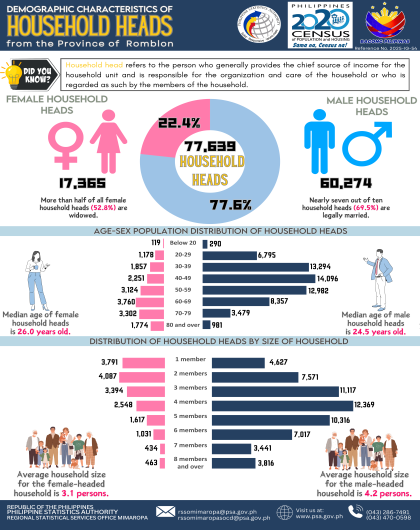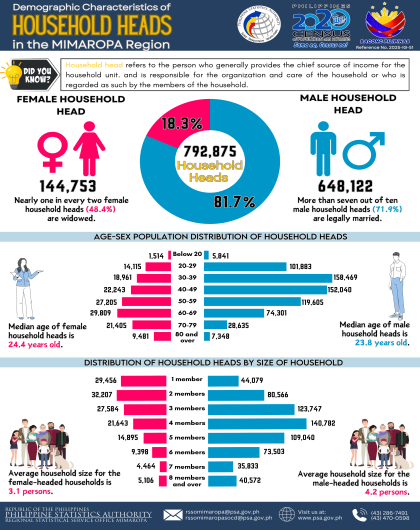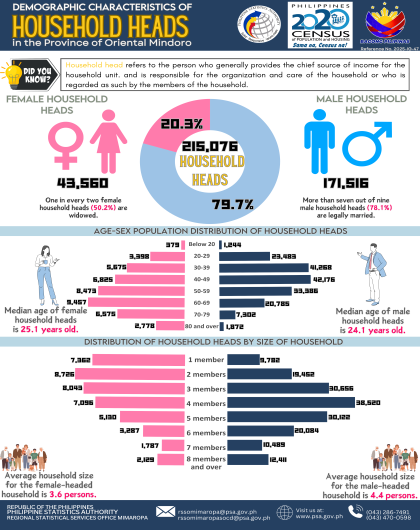Roman Catholics account for 72.6 percent of the total population
Of the 3,228,558 total population of the MIMAROPA Region in 2020, nearly three fourths or 2,342,976 persons (72.6%) reported Roman Catholic as their religious affiliation. It was followed by Iglesia ni Cristo with 124,048 persons (3.8%). In 2015, these were the top two religious affiliations in the region. Completing the top five religious affiliations in 2020 are Islam with 113,804 persons (3.5%), Seventh Day Adventist with 80,919 persons (2.1%), and Tribal Religion with 68,603 persons (1.3%). (Figure 1 and Table 1)
Marinduque has the highest proportion of total population with Roman Catholic as religion
Among provinces in the region, Marinduque posted the highest proportion of Roman Catholics, comprising 87.9 percent of its total population. It was followed by Oriental Mindoro with 80.5 percent, and Occidental Mindoro with 74.5 percent. Meanwhile nearly three in every four residents (73.9%) in the City of Puerto Princesa, the lone highly urbanized city of the region, reported Roman Catholic as their religious affiliation. (Table 2)
In terms of magnitude, Oriental Mindoro has the highest number of Roman Catholics in the region with 731,601 persons. This translates to more than three in every ten persons (31.2%) in the region who were affiliated with Roman Catholic are in Oriental Mindoro. This was followed by Palawan (excluding the City of Puerto Princesa) with 568,374 persons (24.3%).
Mogpog, Marinduque leads the municipalities with the highest proportion of Roman Catholics
Among the 71 municipalities and one component city in the region, the municipality of Mogpog in Marinduque had the highest proportion of total population who reported Roman Catholic as their religious affiliation with 33,159 persons or 96.1 percent of its total population of 34,516 persons. It was followed by the following municipalities in Palawan, namely Cagayancillo (95.3%), Cuyo (92.5%), and Araceli (91.9%). The municipality of Santa Cruz in Marinduque had 91.9 percent of its total population who are religiously affiliated with Roman Catholic. (Figure 2)
Moreover, five other municipalities across the region posted proportions higher than
90.0 percent namely Banton in Romblon (91.5%), Magsaysay in Palawan (91.3%), Lubang in Occidental Mindoro (90.6%), and Torrijos and Boac in Marinduque (90.4% each). (Figure 2)
City of Calapan in Oriental Mindoro has the highest number of Roman Catholics among component city and municipalities
In terms of the number of Roman Catholics by component city and municipality, the City of Calapan in Oriental Mindoro posted the highest number at 129,242 persons or 88.7 percent of its total population. This was followed by the municipalities of San Jose in Occidental Mindoro with 125,509 persons (81.9%) and Naujan in Oriental Mindoro with 94,565 persons (86.3%). Eight other municipalities had at least 50,000 persons of their total populations who were affiliated to Roman Catholic. (Table 3)
Occidental Mindoro has the highest proportion of total population with Iglesia ni Cristo as religion
Among provinces in the region, Occidental Mindoro posted the highest proportion of individuals affiliated with Iglesia ni Cristo, comprising 5.6 percent of its total population. It was followed by Oriental Mindoro (3.7%), and Romblon (3.6%). Meanwhile nearly one in every 20 residents (4.8%) in the City of Puerto Princesa reported Iglesia ni Cristo as their religious affiliation. (Figure 3)
Concepcion in Romblon leads the municipalities with the highest proportion of Iglesia ni Cristo
Among the 71 municipalities and one component city in the region, the municipality of Concepcion in Romblon had the highest proportion of total population who reported Iglesia ni Cristo as their religious affiliation with 300 persons or 8.4 percent of its total population of 3,561 persons. It was followed by the following municipalities in Occidental Mindoro, namely Sablayan (7.7%), Rizal (7.2%), and Santa Cruz (7.1%). The municipality of Magdiwang in Romblon ranked fifth with 6.4 percent of its total population is religiously affiliated with Iglesia ni Cristo. (Figure 4)
San Jose in Occidental Mindoro has the highest number of Iglesia ni Cristo among component city and municipalities
In terms of the number of Roman Catholics by component city and municipality, San Jose in Oriental Mindoro posted the highest number at 8,568 persons or
5.6 percent of its total population. This was followed by the municipalities of Sablayan in Occidental Mindoro with 7,152 persons (7.7%) and Naujan in Oriental Mindoro with 5,252 persons (4.8%). (Table 4)
Nearly one in every nine residents in Palawan has Islam as religion
Islam was the most predominant religion in Palawan among provinces in the MIMAROPA Region. This accounts for 101,586 persons or 10.8 percent of its total population. Moreover, the City of Puerto Princesa followed with 2.9 percent. Meanwhile, other provinces in the region registered a proportion of Islam of less than
0.5 percent. (Figure 5)
TECHNICAL NOTES
I. Introduction
The Philippine Statistics Authority conducted the 2020 Census of Population and Housing (2020 CPH) in September 2020, with 01 May 2020 as reference date.
The 2020 CPH was the 15th census of population and 7th census of housing that was undertaken in the Philippines since the first census in 1903. It was designed to take inventory of the total population and housing units in the country and collect information about their characteristics.
The Philippine Standard Geographic Codes as of March 2022 was used for the disaggregation of geographic levels of the 2020 CPH.
II. Data Collection
The statistics presented in this report were based on the information provided by the respondent or any responsible household member who may provide accurate answers to the questions and give correct information about all the household members; hence, it should be used with caution.
III. Methodology
The population and housing censuses in the Philippines are conducted on a “de jure” basis, wherein a person is counted in the usual place of residence or the place where the person usually resides. The enumeration of the population and collection of pertinent data in the 2020 CPH referred to all living persons as of 01 May 2020.
For the 2020 CPH, data on the Religious Affiliation of all household members and those persons residing at institutional living quarters were collected by asking the respondent, “What is _____’s religious affiliation?”.
IV. Concepts and Definition of Terms
A household is a social unit consisting of a person living alone or a group of persons who sleep in the same housing unit and have a common arrangement in the preparation and consumption of food.
Household population comprises of persons who belong to a household.
Institutional living quarter (ILQ) is a structurally separate and independent place of abode intended for habitation by large groups of individuals. Such a quarter usually has certain common facilities such as a kitchen and dining room, toilet and bath, and lounging area which are shared by the occupants.
Institutional population comprises of persons who are found living in ILQs.
Religious affiliation refers to a particular system of beliefs, attitudes, emotions, and behaviors constituting man’s relationship with the powers and principalities of the universe. Moreover, religion is either defined as: (a) religious or spiritual belief of preference, regardless of whether or not this belief is represented by an organized group or (b) affiliation with an organized group having specific religious or spiritual tenets.
V. Dissemination of Results
The 2020 CPH Press Release and statistical tables are publicly available at the PSA website, https://psa.gov.ph/population-and-housing.






